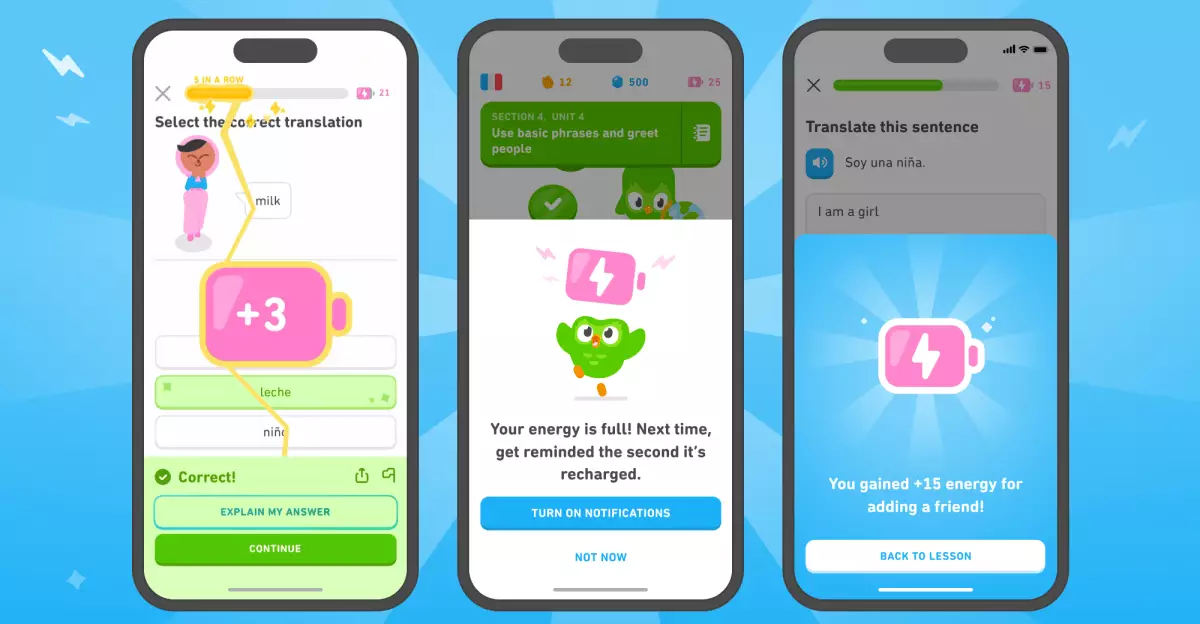In a remarkable shift aimed at enhancing user engagement, Duolingo is abandoning its outdated heart system and introducing a dynamic energy mechanic. This transformation is not merely a cosmetic update; it’s a philosophical re-evaluation of how language learning should be approached. The past system was punitive. Users lost hearts for mistakes, essentially penalizing them for errors rather than fostering a growth mindset. By adopting an energy system, Duolingo is rebranding the user experience to focus on building confidence and motivation among learners.
The crux of this new approach lies in redefining failure. Instead of inciting anxiety each time a learner stumbles, the energy system allows for a more forgiving learning environment. Each exercise costs one unit of energy, but users are rewarded through bonus energy for consecutive correct answers. This system encourages a positive reinforcement loop, allowing learners to celebrate their successes while minimizing discouragement from occasional mistakes. It’s a significant departure from traditional educational paradigms, where failure is often highlighted, and success feels tethered to rigid grading systems.
A Gamified Experience for All
Duolingo’s changes are underpinned by a desire to gamify the learning experience further. The gamification elements are evident with the introduction of energy bars, which hold a maximum of 25 units—offering a visual cue of progress and potential. By framing language learning as a game, Duolingo taps into our intrinsic motivation, making the act of learning feel less like a chore and more like a fun, engaging activity. The randomized energy recuperation for multiple correct answers adds an element of unpredictability and excitement that can keep users coming back for more.
Furthermore, the onboarding of advanced technologies, such as AI, positions Duolingo as a frontrunner in the ed-tech landscape. The CEO’s announcement of an “AI-first” strategy underscores a commitment to innovation, reflecting a broader trend where technology is harnessed to break down barriers in education. With the recent doubling of language courses thanks to AI, Duolingo embodies a forward-thinking ethos that combines user experience with cutting-edge technology. This juxtaposition of gamification and AI creates an unparalleled learning environment where progress can be tailored to individual needs and paced according to personal development.
Embracing Flexibility and Inclusivity
This old model’s rigidity often meant frustrating cutoffs – users could find themselves “failing” the first lesson of their daily practice, prompting an immediate sense of defeat. The energy system challenges that traditional framework by allowing a more forgiving and fluid learning journey. If a user makes mistakes, it doesn’t mean their day is over; they can keep trying and learning without feeling obstructed by a loss of hearts. This inclusivity aims to accommodate different learning styles and rates, making it particularly appealing to a broader audience.
Moreover, the structure also addresses the psychological barriers many learners face. By promoting a culture that reorients failure as a step towards success, Duolingo improves chances for learners who may feel intimidated by language acquisition. As users delve deeper into their chosen languages, the newfound freedom to make mistakes could empower them to engage in more ambitious projects – be it conversing with native speakers or diving into complex grammatical structures. It’s an enriching cycle that feeds back into learning outcomes, making it easier than ever for users to remain invested.
The Future of Language Learning
In the immediate future, the energy system will be available on iOS, while Android users will continue to operate under the heart model for a time. This staggered rollout offers a unique chance for Duolingo to analyze user responses and tweak the system as needed, ensuring that they are not merely dropping one model for another without ample research and testing. This level of intentionality reflects a conscientious understanding that users’ needs are diverse and must be prioritized in educational design.
Ultimately, Duolingo’s shift toward an energy-centric model is a beacon of innovation in the ed-tech realm, harnessing elements of gaming, technology, and psychology to create a rich tapestry of learning possibilities. As they navigate this shift, the implications for future learning experiences could set a precedent for other educational platforms aiming to enhance user engagement and success in a similarly transformative manner.

